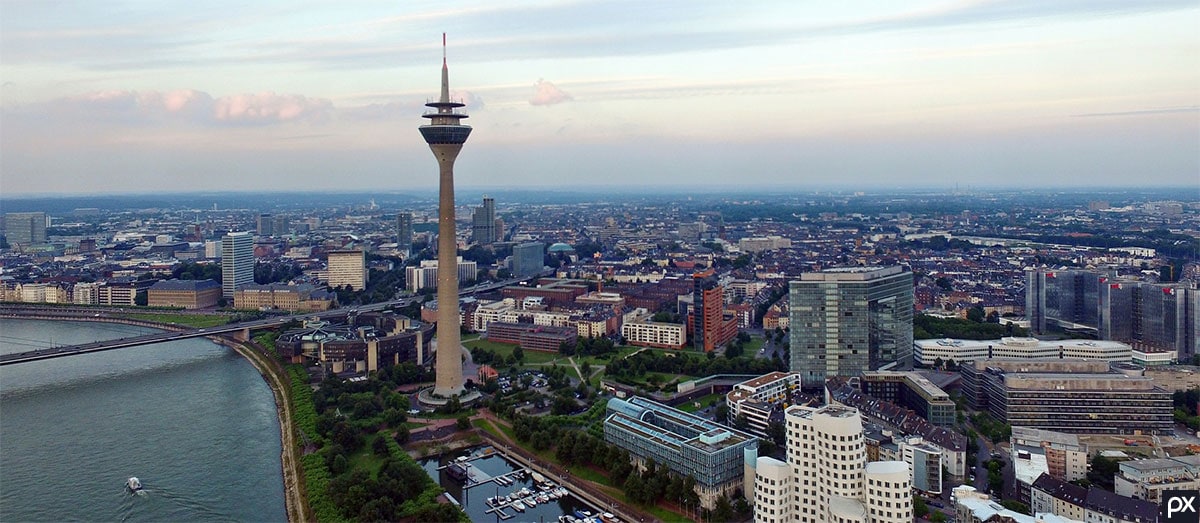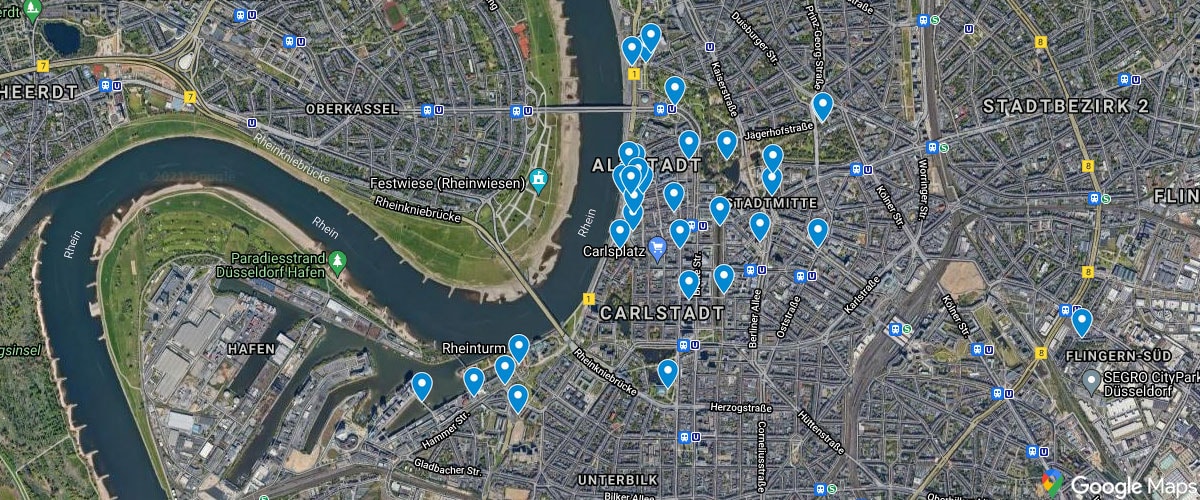The longest bar in the world, the Rhine promenade, the old town, unusual street art, the Königsallee shopping mile, the Rhine Tower, the many parks and museums… the city of Düsseldorf has many sights to offer and is therefore great for a city trip. So we took 2 days to get to know the state capital of North Rhine-Westphalia on our own and on foot.

Table of contents
Things to know about Düsseldorf
The city of Düsseldorf is the state capital of North Rhine-Westphalia and the second largest city in the state after Cologne. With around 620,000 inhabitants, it is also the seventh largest city in Germany. Düsseldorf was first mentioned in the 12th century as a place at the mouth of the river Düssel into the Rhine and received city rights in 1288. Today, the Rhine metropolis is one of the most important economic centres in Germany: Düsseldorf is a trade fair city, home to many listed companies, and the German location with the highest turnover for management consulting, auditing and fashion. The cityscape is characterized by numerous high-rise buildings, church towers, the 240-meter-high Rhine Tower and seven Rhine bridges. In addition, you will find buildings by well-known star architects such as Frank O. Gehry or David Chipperfield in the city.
Sights & beautiful photo spots in Düsseldorf
The most important sights of Düsseldorf are almost all centrally located in the old town and therefore within easy walking distance. Only the Volksgarten, the Kiefernstrasse, the Schloss Benrath and the Kaiserswerth are located just outside the city center and are therefore easier to reach by car or public transport.
The old town of Düsseldorf
From our hotel The Wellem we “fell” almost directly into the old town of Düsseldorf. The old town is the cultural, historical and political heart of the state capital. In addition to the town hall, numerous gastronomic facilities as well as the Kunstsammlung Nordrhein-Westfalen and the Kunstakademie Düsseldorf are located here. Most of the old town is a car-free zone, which we really liked. The old town is bordered in the west by the Rhine promenade, in the northeast by the Hofgarten, in the south by the Carlstadt and in the east by the district Stadtmitte.
Very worth seeing is the historic town hall on the market square, which was built in the years 1570 to 1573 and then underwent numerous extensions and changes; today it consists of a total of five building parts. From the very beginning, the town hall has been the seat of the city council and municipal administration throughout. Directly in front of the town hall on the central market square is the equestrian statue of Jan Wellem, Elector of the Palatinate and native of Düsseldorf. In the old town you can also visit the Heinrich Heine House, which stands on the site of the demolished house where the poet was born.
“The longest bar in the world”
Before our visit to Düsseldorf, we have often heard the slogan“The longest bar in the world”, which is used in the carnival song “… where is our Altbier?” from 1978 and have always asked us what it is all about. It does not describe a single counter of a pub, but the entirety of the more than 260 pubs, bars and restaurants around the heart of Düsseldorf’s old town “Bolkerstraße”. You can do pub hopping here almost wonderfully 😉
The Königsallee
When you think of Düsseldorf, the first thing that comes to mind is the “Kö”. The Königsallee – called “Kö” for short – is Düsseldorf’s most famous boulevard and one of the leading luxury shopping streets in Europe. In fact, most of the shops and boutiques are only located on the eastern side of the boulevard. The tree-lined city moat separates this side from the rather quiet western side of the street, which has now developed into a hotel location of the luxury category. We have to admit that we were not particularly enthusiastic about the “Kö”. We somehow like car-free pedestrian zones in the inner cities better.
The Hofgarten
A green oasis in Düsseldorf’s city centre is the Hofgarten with an area of almost 28 hectares. The oldest part of the garden was created in 1769 in the French-classical style – making the Düsseldorf Hofgarten Germany’s first and oldest Volksgarten. In the park you will find various styles of horticulture, e.B. strictly baroque to the natural English landscape garden, which have shaped the hofgarten over the years of its use. Particularly worth seeing were the Jägerhofallee and the Jägerhof Castle at the end of it as well as the area around the northern Düssel.
The Burgplatz
The area around the Burgplatz is very busy and we really liked it. Here you can sit down on the large Rhine stairs and watch the action on the Rhine promenade. Striking on the square is the round castle tower, which is the last remnant of the former ducal castle, which existed until 1872 and 1896 respectively. Today, the tower is home to the Maritime Museum, one of the oldest inland navigation museums in Germany. A nice photo spot is the colored Kuhna wall “Rivertime” at the Rhine stairs and Rhine promenade, which consists of many small colorful mosaics. The oldest building on the square is the three-aisled Basilica of St. Lambertus, whose history is documented until 1159 and whose construction was completed in 1394.
The Pillar Saints
During our walk through Düsseldorf, we repeatedly noticed advertising columns on which figures are placed at the top. We found out that this is a project of the artist Christoph Pöggeler. Since 2001, there have been these figures for which people from everyday life have been models: be it a mother with her child, a kissing couple or a businessman. To date, there are 10 of these sculptures, also known as pillar saints. We think the idea is really great, it gives such a rather boring advertising column that certain extra 🙂
A walk along the banks of the Rhine
In the afternoon we walked along the banks of the Rhine in the best weather with an ice cream in our hands. We love cities that are located on the water and have a waterfront promenade for strolling, because somehow that gives a city a special flair. And that’s exactly how we experienced the banks of the Rhine in Düsseldorf: excursion boats dock and depart, tourists and locals sit on the walls with a cool drink, relax on deck chairs or simply enjoy the sun on a walk along the Rhine. Fantastically beautiful! We were also able to discover some sights during our walk, such as the Tonhalle or the Ehrenhof at the Kunstpalast, which are only a few meters away from the banks of the Rhine.
The Rhine Tower
The 240-metre-high Rhine Tower shapes the skyline of Düsseldorf like no other building. The TV Tower was built between 1979 and 1982 and is now one of the tenth highest television towers in Germany. It is located at the southern end of the city centre directly at the Medienhafen and next to the North Rhine-Westphalian state parliament. The Rhine Tower houses a restaurant at a height of 172 meters, a self-service restaurant and a viewing platform. But it has a completely different finesse to offer, namely the largest decimal clock in the world. For this purpose, there are 39 porthole lamps arranged one above the other on the tower shaft in three height sections: The top group represents the hours, the middle the minutes and the lower the seconds. This watch is the largest decimal “timescale” in the world, according to the Guinness Book of Records.
The Media Harbour
Over the years, the former Rhine port has developed from a trading port to a trendy trendy district. In today’s Media Harbour you will find countless restaurants as well as numerous companies, especially from the fields of media & communication, art & culture as well as fashion & architecture. We particularly liked the mix of old and new: buildings built by international star architects stand here next to the old tracks and quay walls.
Absolute eye-catchers are the three-part, organically shaped Gehry buildings in the New Zollhof, an ensemble of buildings that was inaugurated in 1999. The Canadian-American architect and designer Frank O. Gehry has thus created a real Düsseldorf landmark. We were slightly irritated and a bit confused when we stood in front of the “city gate”. Of course we had a picture in our heads of what such a city gate could look like, but that it is a murderous steel and glass building and there is an office building in it… we didn’t expect that at all.
The Volksgarten & the Time Field
The Volksgarten is the most beautiful and oldest part of the Südpark, which with an area of 70 hectares is the largest and most visited park in Düsseldorf. At the western entrance of the Volksgarten we discovered the art installation “Zeitfeld” by the Düsseldorf artist Klaus Rinke, which was set up there in the course of the Federal Garden Show in 1987. The artwork consists of 24 station clocks on six-meter-high columns, all pointing in the same direction and all indicating the same time. Somehow a cool photo opportunity!
Street art in Kiefernstraße
When we stroll through cities, we always keep our eyes open for street art, because we just really like something like that. And lo and behold, we were also able to discover numerous murals in Düsseldorf on Kiefernstraße in the Flingern-Süd district. Kiefernstraße became known in the 1980s for its left-alternative squatter scene. Today, numerous house facades over a length of over 200 meters in street art style have been artistically designed and thus become a real sight.
More Sights & Photo spots
During our walk through Düsseldorf we discovered some other sights and beautiful photo spots, such as the sophisticated Stahlhof, in which the Düsseldorf Administrative Court is located or the Düsseldorf Schauspielhaus, which is architecturally a real feast for the eyes. Also known is the fountain figure “Father Rhine and his Daughters” in front of the Ständehaus, which was erected as a monument in 1897.
Dusseldorf, you really surprised us positively ❤
We really enjoyed our city tour and our stay in the Rhine metropolis and we were thrilled with what the city has to offer. What we unfortunately did not manage to visit due to time constraints was benrath Castle, the EKŌ House and the Kaiserswerth.
A map with all the sights in Düsseldorf
On the following Google MyMaps map we have drawn all important sights in Düsseldorf. If an important or interesting point is missing, you are welcome to add it as a comment below.


